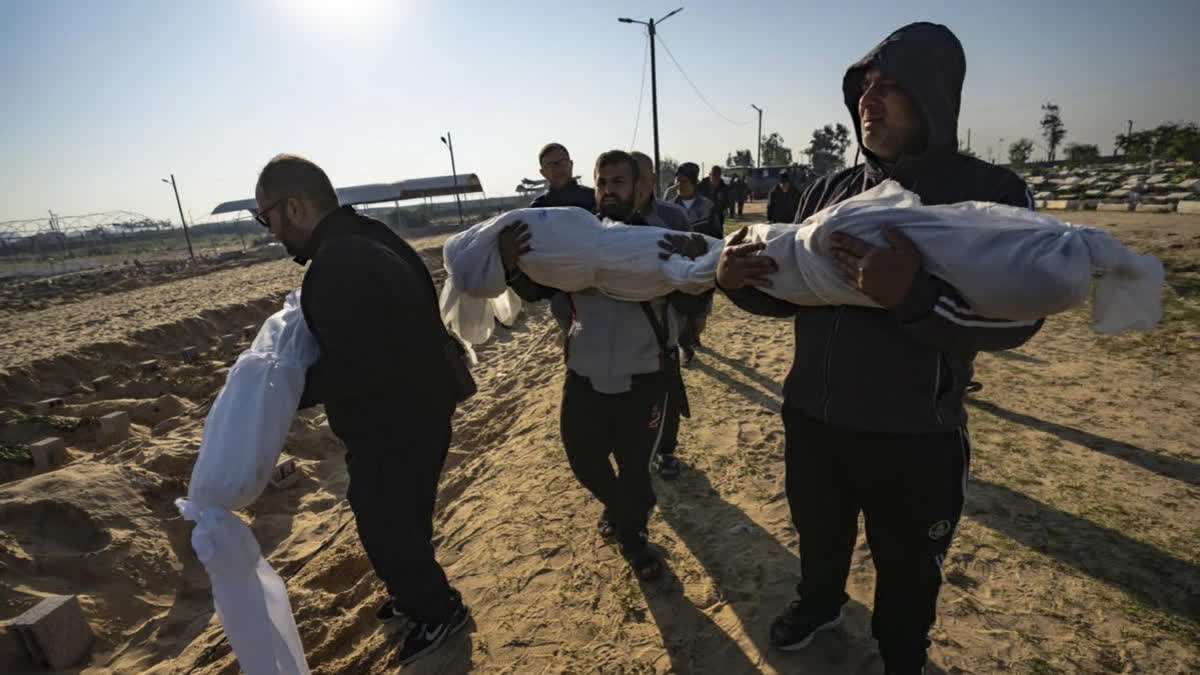While Israel has continued with its illegal occupation of Palestine for decades, 2023 was the darkest chapter of this grim story. The Zionist state leveraged its influence, technology, and power across Europe to orchestrate a genocide with few historical parallels since the World Wars. Gaza Strip, known as the 'world's largest open-air prison' is one of the most densely populated places on earth. Around two million people live on this strip of land, just 41 kilometres long and 6 to 12 kilometres wide.
On October 7, Hamas, the Palestinian Islamist movement that governs the Gaza Strip, carried out an unprecedented surprise attack on Israel. Hamas militants infiltrated southern Israel causing havoc in nearby communities. Armed Hamas operatives, some riding motorcycles, entered Israel, killing several hundred people in bordering small towns. Video footage showed them taking Israeli citizens— including mothers, small children, and the elderly —hostage and transporting them across the Gaza border. It was later known that Hamas had kidnapped around 240 people.
According to Israeli reports, the attack resulted in the deaths of about 1,140 individuals, predominantly civilians (Israel, for the first few weeks after the attack, claimed Hamas had killed 1,400 people but later changed the figure to 1,147).
Raining hell
The attack left Israel see red with its Prime Minister Benjamin Netanyahu, who was facing corruption charges and an uncertain political future, declaring war against Hamas. Israel started bombing Gaza, hitting civilian areas for the next several weeks while ordering a complete siege of the beleaguered strip. Water, electricity and food supplies were cut off and the entire population in Gaza, half of which is under 18, was left to face the brutal onslaught with minimal healthcare and hospital supplies and ever dwindling food and water reserves.
Israel’s air campaign was unusually fierce, breaking all previous records. According to a report by The Economist, the Zionist state dropped 29,000 air-to-ground munitions on Gaza, equivalent to around 500 bombs per day. What made the unprecedented bombing more lethal was that at least 40 per cent of these 29,000 bombs were unguided. These munitions, also called "dumb" bombs, do not have any internal guidance systems to enhance their precision. They typically follow the trajectory of their initial drop, causing extensive damage beyond the planned target area.
Ground ops
While flattening most of Gaza with air strikes, Israel also launched a large-scale ground invasion of the Strip on October 27, moving ahead into the territory with tanks, bulldozers, and IDF infantry. Netanyahu, who by then was buoyed by the support from his trusted allies, said the ground invasion aimed to "destroy Hamas and overthrow its governance of the Gaza Strip". He called the ground invasion the second phase of the war against Hamas.
Deaths and destruction
Israeli air strikes and ground operations have killed a staggering over 19,000 people so far, according to the Gaza Health Ministry. The number is conservative as it is feared that thousands of unaccounted people are buried under rubble across Gaza. More than 50,000 people have been injured in the war so far. Around 70 per cent of those killed in Gaza were women and children. As per an assessment carried out by the United Nations, nearly 40,000 buildings (18 per cent of all structures) have been damaged or destroyed in the Gaza Strip since October 7.
World response
Israel’s Western allies such as the United States, France, Germany, the United Kingdom and various European countries condemned the Hamas attack and expressed solidarity with Tel Aviv affirming its "right to defend". On the contrary, countries in the Muslim world, including members of the Axis of Resistance, supported the Palestinians. The increase in violence was attributed to Israel's occupation of the Palestinian territories, considered to be the root of the conflict.
Targeting hospitals
Not caring about the international humanitarian laws, Israel targeted the healthcare facilities in Gaza Strip to make the unfolding tragedy graver as tens of thousands of fleeing civilians took shelter in hospitals. Israel bombed hospitals, killed doctors, paramedics, patients, arrested senior medicos, while claiming that hospitals were being used as Hamas bases. The World Health Organization issued multiple statements condemning the Israeli actions with the latest one released on December 17.
In it, the WHO said its staff participated in a joint UN mission to Al-Shifa Hospital in north Gaza on December 16 to deliver health supplies and assess the situation in the facility. The WHO team described the emergency department at Al-Shifa as a "bloodbath", with hundreds of injured patients inside, and new patients arriving every minute. "Patients with trauma injuries were being sutured on the floor, and limited to no pain management is available at the hospital. WHO staff said that the emergency department is so full that care must be exercised to not step on patients on the floor. Critical patients are being transferred to Al-Ahli Arab Hospital for surgeries," the WHO said in its statement.
Once the most important and largest referral hospital in Gaza, Al-Shifa, the statement added, now houses only a handful of doctors and a few nurses, together with 70 volunteers, working under what WHO staff described as "unbelievably challenging circumstances" and calling it a "hospital in need of resuscitation." At present, Al-Ahli Arab Hospital remains the only partially functional hospital in north Gaza along with three minimally functional hospitals – Al-Shifa, Al Awda and Al Sahaba Medical Complex - down from 24 before the war.
Weeklong truce and hostage crisis
Followed by mediation efforts primarily by Qatar, Israel and Hamas agreed to a weeklong truce that commenced on November 24 and concluded on December 1, during which Hamas released 105 hostages, including 80 Israelis, while Israel released 240 Palestinian prisoners, including 107 children. Most of the freed Palestinians had not been convicted of a crime.
Soon after the expiration of the truce, Israel resumed bombing Gaza, killing nearly 200 people in the first 24 hours. While Qatar and Egypt attempted to reinstate the truce, Israel maintained a hawkish posture as it vowed to "destroy Hamas".
Amid this, on December 8, the United Nations Security Council (UNSC) failed to adopt a resolution calling for a ceasefire in Gaza after the United States vetoed it. The vote took place, with 13 members in favour. The US voted against it, with the UK abstaining. Owing to the US veto, the resolution was not adopted.
According to a UN spokesperson, the vote followed Secretary-General António Guterres’s letter dated 6 December, invoking Article 99 of the Charter of the United Nations, which reads: "The Secretary-General may bring to the attention of the Security Council any matter which in his opinion may threaten the maintenance of international peace and security."
As calls for truce and ceasefire failed, IDF, meanwhile, "mistakenly" killed three Israeli hostages, which triggered clear signs of unease among Israel's allies.
MORE 2023 YEAR END STORIES
- Summing up 2023 for India: Chandrayaan-3 brings joy, World Cup breaks hearts, Silkyara saves the day
- Year-ender 2023: From Article 370 to same-sex marriage, key judgements Supreme Court delivered
- Year-ender 2023: Rise and rise of AI; what future holds for us
- Year-ender 2023: ODI World Cup: A heartbreaking climax to fairytale run for Men in Blue
- Year-ender 2023: India at Asian Games, a tale of resilience, achievements, and sporting glory
- Year-ender 2023: India over the Moon after Chandrayaan-3's historic lunar landing
- 2023 year-ender: When Manipur violence rocked the nation, streets and the Parliament



